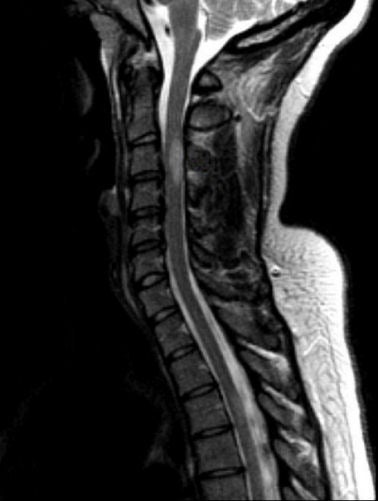
|
A 25 year-old woman presented with paresthesias of the arms and legs for two weeks. The paresthesias resolved in the legs but persisted in the arms. Other than increased reflexes, the neurological examination was normal. |

![]()
![]()
| Transverse Myelitis (TM): T2-weighted sagittal MRI. Note
the area of increased signal in the posterior aspect of the spinal
cord at the C3-C4 level. If one looks more closely, one can
see more subtle
additional abnormalities at the T3 and T4 levels.
TM is an inflammatory and demyelinating disorder of the spinal cord. Symptoms develop acutely over hours to days, resulting in partial or complete spinal cord syndromes with sensory loss, weakness and bladder/bowel disturbance below the level of the lesion. Many cases are associated with significant back or nerve root pain. Most patients make a good recovery although improvement may be delayed for weeks to months. TM is usually idiopathic and typically seen as a delayed autoimmune response to a viral or bacterial infection or an immunization. Most cases are monophasic and do not recur unless there is an underlying disorder, most often multiple sclerosis (MS) or a connective tissue disease, most notably SLE or Sjögren's syndrome. Thus, while TM may occasionally present as the first attack of MS, the diagnosis of MS should not be made on the basis of one episode of TM unless there have been previous neurological episodes separated by time and space. |
Revised
11/29/06
Copyrighted 2006. David C Preston